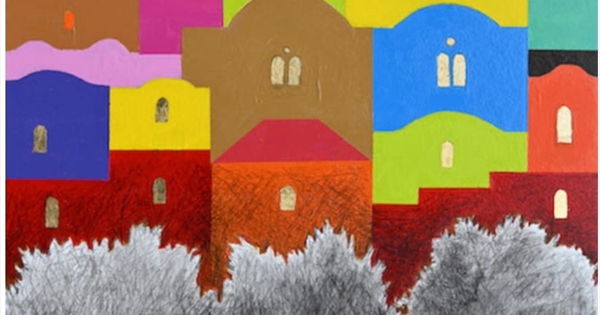The Iraqi artist “Hosni Radwan” opens the visual spaces to chromatic expressions that contrast with the shapes according to the calmness of warm and cold colors, with an expressive brevity through which he reveals the power of the line in highlighting the color, and with details simple, which allow us to grasp the paradoxes of color shades according to plastic relationships The exchange between design and expression, and the measures that are imposed, to remain free among the colors that are gradually generated with aesthetic formations with visually comfortable external reflections, in order to touch the strategies of urban revitalization in ancient cities, and with multiple paradoxes, even organizational and contradictory on several levels that include a vision supported by a contemporary plastic sequence is a tactic The fading of the old classic, and its replacement with a renewal through which the dark features crystallize, linked to the multiplicity of c olori, to erase the idea of stability and conservation of the ancient, but within the temporal and spatial changes of the modern era, which needs more discoveries to achieve the artistic meaning that feeds on the idea of contradictions in cities in general, and in the city of Jerusalem identified by the artist “Hosni Radwan” in his virtual exhibition. Does color play different imaginary practices that provoke the silent expression of the artist? Or perhaps the discoveries of the social structure are the strength of warm colors and their penetration among other artistic components? And is the natural multicolor in the painting the result of the evolution and new approach to the life of ancient cities?
Visual analyzes presented by the artist “Hosni Radwan”, born in Baghdad, in an artistic setting that stimulates the senses of the recipient, which leads to an increase in chromatic awareness mixed with reactions that are intertwined between the meditator and the artist far from the oscillation between the disappearance of ancient monuments, and the strength of their renewal according to the needs of the modern era or better of the present With simple chromatic proposals to revive the idea of social pluralism linked to cities, and modifications that arise from imaginative expressions with effects of contrast, saturation, play of shadows and shadows, low and high tones, etc. To continue complex existence, such as castles, fortresses and old houses, which visually increase between spaces that shrink as we get closer and expand as we move away. Is visual perception different with the times? Or the contradictions in ancient cities between high and low, large and small, with specific representations? Do the colors in Hosni Radwan’s paintings evoke warm and right impressions for the recipient? Or does he define the city of Jerusalem and its significance by the level of joyful colors his visitor feels?
Colorful spaces that separate ancient and modern, with an aesthetic with multiple urban and social faces that combine the expressive imagination and realistic logic of ancient cities and the value of their modernization, in proportion to the aesthetic vision of ancient societies and the strength of their history presence in a vibrant modernity, far from the gaps of the abolition of the old, and its replacement with what is modern over time, especially Simple, like the old markets and houses, without erasing the visual impact that fascinates the visitor of those cities.
Duha Abdul Raouf Al Mulla


